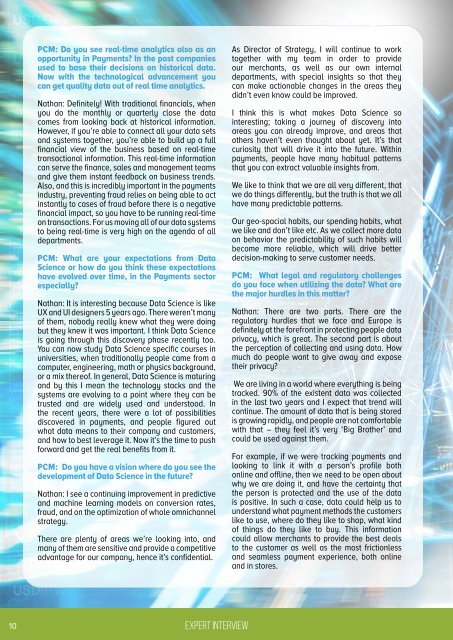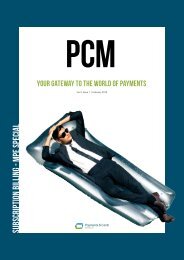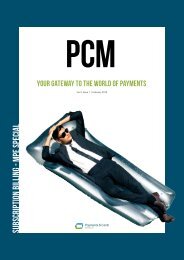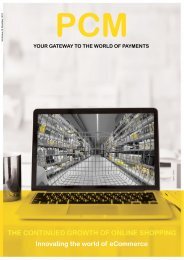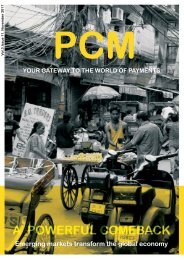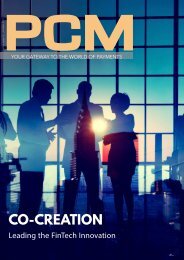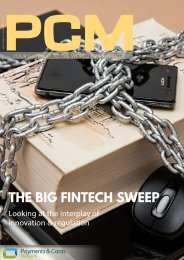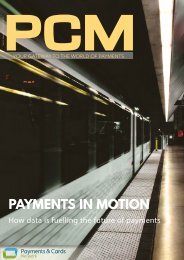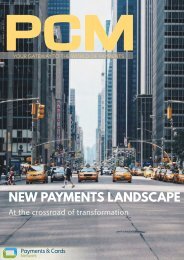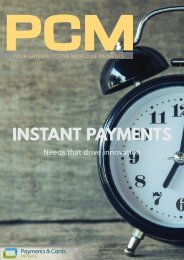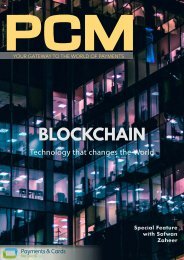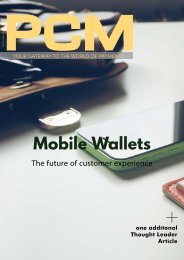Create successful ePaper yourself
Turn your PDF publications into a flip-book with our unique Google optimized e-Paper software.
PCM: Do you see real-time analytics also as an<br />
opportunity in Payments? In the past companies<br />
used to base their decisions on historical data.<br />
Now with the technological advancement you<br />
can get quality data out of real time analytics.<br />
Nathan: Definitely! With traditional financials, when<br />
you do the monthly or quarterly close the data<br />
comes from looking back at historical information.<br />
However, if you’re able to connect all your data sets<br />
and systems together, you’re able to build up a full<br />
financial view of the business based on real-time<br />
transactional information. This real-time information<br />
can serve the finance, sales and management teams<br />
and give them instant feedback on business trends.<br />
Also, and this is incredibly important in the payments<br />
industry, preventing fraud relies on being able to act<br />
instantly to cases of fraud before there is a negative<br />
financial impact, so you have to be running real-time<br />
on transactions. For us moving all of our data systems<br />
to being real-time is very high on the agenda of all<br />
departments.<br />
PCM: What are your expectations from Data<br />
Science or how do you think these expectations<br />
have evolved over time, in the Payments sector<br />
especially?<br />
Nathan: It is interesting because Data Science is like<br />
UX and UI designers 5 years ago. There weren’t many<br />
of them, nobody really knew what they were doing<br />
but they knew it was important. I think Data Science<br />
is going through this discovery phase recently too.<br />
You can now study Data Science specific courses in<br />
universities, when traditionally people came from a<br />
computer, engineering, math or physics background,<br />
or a mix thereof. In general, Data Science is maturing<br />
and by this I mean the technology stacks and the<br />
systems are evolving to a point where they can be<br />
trusted and are widely used and understood. In<br />
the recent years, there were a lot of possibilities<br />
discovered in payments, and people figured out<br />
what data means to their company and customers,<br />
and how to best leverage it. Now it’s the time to push<br />
forward and get the real benefits from it.<br />
PCM: Do you have a vision where do you see the<br />
development of Data Science in the future?<br />
Nathan: I see a continuing improvement in predictive<br />
and machine learning models on conversion rates,<br />
fraud, and on the optimization of whole omnichannel<br />
strategy.<br />
There are plenty of areas we’re looking into, and<br />
many of them are sensitive and provide a competitive<br />
advantage for our company, hence it’s confidential.<br />
As Director of Strategy, I will continue to work<br />
together with my team in order to provide<br />
our merchants, as well as our own internal<br />
departments, with special insights so that they<br />
can make actionable changes in the areas they<br />
didn’t even know could be improved.<br />
I think this is what makes Data Science so<br />
interesting; taking a journey of discovery into<br />
areas you can already improve, and areas that<br />
others haven’t even thought about yet. It’s that<br />
curiosity that will drive it into the future. Within<br />
payments, people have many habitual patterns<br />
that you can extract valuable insights from.<br />
We like to think that we are all very different, that<br />
we do things differently, but the truth is that we all<br />
have many predictable patterns.<br />
Our geo-spacial habits, our spending habits, what<br />
we like and don’t like etc. As we collect more data<br />
on behavior the predictability of such habits will<br />
become more reliable, which will drive better<br />
decision-making to serve customer needs.<br />
PCM: What legal and regulatory challenges<br />
do you face when utilizing the data? What are<br />
the major hurdles in this matter?<br />
Nathan: There are two parts. There are the<br />
regulatory hurdles that we face and Europe is<br />
definitely at the forefront in protecting people data<br />
privacy, which is great. The second part is about<br />
the perception of collecting and using data. How<br />
much do people want to give away and expose<br />
their privacy?<br />
We are living in a world where everything is being<br />
tracked. 90% of the existent data was collected<br />
in the last two years and I expect that trend will<br />
continue. The amount of data that is being stored<br />
is growing rapidly, and people are not comfortable<br />
with that – they feel it’s very ‘Big Brother’ and<br />
could be used against them.<br />
For example, if we were tracking payments and<br />
looking to link it with a person’s profile both<br />
online and offline, then we need to be open about<br />
why we are doing it, and have the certainty that<br />
the person is protected and the use of the data<br />
is positive. In such a case, data could help us to<br />
understand what payment methods the customers<br />
like to use, where do they like to shop, what kind<br />
of things do they like to buy. This information<br />
could allow merchants to provide the best deals<br />
to the customer as well as the most frictionless<br />
and seamless payment experience, both online<br />
and in stores.<br />
10<br />
EXPERT INTERVIEW


